

Copyright © Hans Högman 2019-06-09


There are a lot of references to the Swedish lands
and provinces in the information about each county
below. See the maps of the
provinces, lands and counties at
the end of this webpage for better
understanding of each county's
location.
The counties in the listing below
are ordered in county code order
which is the most common way of
ordering the counties in Sweden.
This is also the geographical order.
The map shows the counties by
their county codes. See the bottom
of this page for a larger resolution
of this map.
pop./km2 = Population per square km.
Stockholm County
County Code: AB
County Capital: Stockholm City
The County of Stockholm is
a county in the eastern
parts of Svealand, Central
Sweden.
Area 6,519 km2 (2,517 sq mi),
population 2,344,124 (2018), density
360 people per km2.
Stockholm County is comprising the
eastern parts of the provinces
(landskap) Uppland and Södermanland
and from 1968 also the City of Stockholm.
The county is subdivided into 26 local administrative
districts - Kommun (Municipalities).
The County Capital is Stockholm.
Major cities: Stockholm (962,154), Solna (80,950),
Sollentuna (72,528) and Södertälje (97,381) [2018].
The county of Stockholm has the highest density of
inhabitants of the Swedish counties and about 20%
of the population of Sweden are living in the County.
Uppsala County
County Code: C
County Capital: Uppsala City
The County of Uppsala is a
county in the northeastern
parts of Svealand. It
comprises most of the western and
northern parts of the province of
Uppland plus a small area of the
southern parts of the province of
Gästrikland.
Area 8,209 km2 (3,170 sq mi),
population 376.354 (2018), density
45.8 pop./km2.
The county is subdivided into 8 local administrative
districts - kommun (municipalities).
The county capital is Uppsala.
The county of Uppsala was established in 1634 and
received its present county lines in 1971.
Major cities: Uppsala (225,164), Enköping 44,429)
and Östhammar (22,048) [2018]. About 2/3 of the
population of the county lives in the City of Uppsala.
Södermanland County
County Code: D
County Capital: Nyköping
The County of
Södermanland is a county
in the southeastern parts
of Svealand. It comprises most parts
of the province of Södermanland
apart from the northeastern part
which forms the southern part of
Stockholm County.
Area 6,060 km2 (2,340 sq mi),
population 294,695 (2018), density
48.6 pop./km2.
The county is subdivided into 9 local administrative
districts - kommun (municipalities).
The county capital is Nyköping.
The county of Södermanland was established in
1634 and carried then the name Nyköping County. It
received its present county lines in 1719.
Major cities: Eskilstuna (105,924), Nyköping (56,011)
and Katrineholm (34,550).
Östergötland County
County Code: E
County Capital: Linköping
The County of
Östergötland is a county in
the northeastern parts of
Götaland. It mostly coincide with the
province of Östergötland. It also
comprise a part of southeastern
Södermanland, a part of northeastern
Småland and a small part of
southeastern Närke.
Area 10,562 km2 (4,078 sq mi),
population 461,583 (2018), density 43.7pop./ km2.
The county is subdivided into 13 local administrative
districts - kommun (municipalities).
The county capital is Linköping.
The county of Östergötland received its present
county lines in 1719.
Major cities: Linköping (161,034), Norrköping
(141,676) and Motala (43,687).
Jönköping County
County Code: F
County Capital: Jönköping City
The County of Jönköping is
a county in the central
parts of Götaland. It is
comprising the northwestern parts of
the province of Småland and part of
southeastern Västergötland.
Area 10,475 km2 (3,256 sq mi),
population 360,825 (2018), density
34.4 pop./km2.
The county is subdivided into 13 local
administrative districts - kommun (municipalities).
The county capital is Jönköping.
The county of Jönköping was established in 1687
when it was separated from the county of
Kronoberg.
Major cities: Jönköping (139,222), Nässjö (31,477)
and Värnamo (34,428).
Kronoberg County
County Code: G
County Capital: Växjö
The County of Kronoberg is
a county in the southern
parts of Götaland. It is
comprising the southwestern parts of
the province of Småland.
Area 8,458 km2 (2,517 sq mi),
population 199,886 (2018), density
23.6 pop./km2.
The county is subdivided into 8 local
administrative districts - kommun
(municipalities).
The county capital is Växjö.
The county of Kronoberg was established in 1674
and received its present shape in 1687.
Major cities: Växjö (92,567), Ljungby (28,573) and
Alvesta (20,150).
Kalmar County
County Code: H
County Capital: Kalmar City
The County of Kalmar is a
county in the southeastern
parts of Götaland. It is
comprising the eastern parts of the
province of Småland and the island of
Öland.
Area 11.218 km2 (4,331 sq mi),
population 243.219 (2018), density 22
pop./km2.
The county is subdivided into 12 local
administrative districts - kommun (municipalities).
The county capital is Kalmar.
The county of Kalmar was established in 1634 but
was periodically consolidated with other counties
until 1683. Öland was an individual county between
1819 - 1824.
Major cities: Kalmar (68,510), Västervik (36,680) and
Oskarshamn (26,928).
Gotland County
County Code: I
County Capital: Visby
County of Gotland; Gotland
is an island in the Baltic
Sea. The county coincides
with the province of Gotland.
Area 3,184 km2 (1,229 sq mi),
population 59,249 (2018), density 18.6
pop./km2.
The county is subdivided into one local
administrative districts - kommun,
Gotlands kommun. The county capital
is Visby.
Major city: Visby (24,272).
Blekinge County
County Code: K
County Capital: Karlskrona
The County of Blekinge is a
county in the southeastern
parts of Götaland. The
county coincides with the province of
Blekinge.
Area 2,941 km2 (1,136 sq mi),
population 159,684 (2018), density
54,3 pop./km2. Blekinge is by area the
smallest county in Sweden.
The county is subdivided into 5 local
administrative districts - kommun (municipalities).
The county capital is Karlskrona.
The county of Blekinge was established in 1683.
Major cities: Karlskrona (66,675), Karlshamn
(32,330) and Ronneby (26,695).
Kristianstad County (former county)
County Code: L
County Capital: Kristianstad
The County of Kristianstad was until
1996 a county in southern Götaland. It
was comprising the eastern parts of the
province of Skåne. The county capital was
Kristianstad.
On 1 January 1997 the the county was consolidated
with the new County of Skåne.
For further information, see Skåne County.
Malmöhus County (former county)
County Code: M
County Capital: Malmö
The County of Malmöhus was until 1996
a county in southern Götaland. It was
comprising the western parts of the
province of Skåne. The county capital
was Malmö.
On 1 January 1997 the the county was consolidated
with the new County of Skåne.
For further information, see Skåne County.
















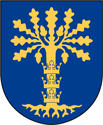




Counties of Sweden
Skåne County
County Code: M
County Capital: Malmö
The County of Skåne is a
county in southern
Götaland. The county
coincides with the province of Skåne
plus a small part of southern Halland.
Area 11,302 km2 (4,364 sq mi),
population 1,364.164 (2018), density
121pop./km2. Skåne is by size the third
largest county in Sweden.
The county is subdivided into 33 local
administrative districts - kommun (municipalities).
The county capital is Malmö.
The county of Skåne was established on January 1,
1997 when the former counties of Kristianstad and
Malmöhus was consolidated.
Major cities: Malmö (339,313), Hälsingborg
(145,415), Kristianstad (84,908) and Lund (122,948).
Halland County
County Code: N
County Capital: Halmstad
The County of Halland is a
county in southwestern
Götaland. It mostly coincide
with the province of Halland.
Area 5,454 km2 (2,106 sq mi),
population 329,352 (2018), density 60.4
pop./km2.
The county is subdivided into 6 local
administrative districts - kommun
(municipalities).
The county capital is Halmstad.
The county of Halland was established in 1719.
Major cities: Halmstad (101,268), Kungsbacka
(83,348) and Varberg (63,630).
Göteborg and Bohus County (former county)
County Code: O
County Capital: Göteborg
The Göteborg and Bohus County was
until the end of 1997 a county in western
Götaland. It was comprising the province
of Bohuslän. The county capital was Göteborg.
On 1 January 1998 the the county was consolidated
with the new County of Västra Götaland.
For further information, see Västra Götaland County.
Västra Götaland County
County Code: O
County Capital: Göteborg
The County of Västra
Götaland is a county in
western Götaland. The
county comprises the provinces of
Bohuslän, Dalsland and Västergötland.
Area 23.942 km2 (9,244 sq mi),
population 1,709,814 (2018), density
71.4 pop./km2.
The county is subdivided into 49 local
administrative districts - kommun
(municipalities).
The county capital is Göteborg.
The county of Västra Götaland was established
January 1, 1998, in the amalgamation of the counties
of Göteborg & Bohuslän, Älvsborg and Skaraborg.
Major cities: Göteborg (571,868), Borås (112,178),
Skövde (55,729), Uddevalla (56,259), Trollhättan
(58,728) and Mölndal (68,152).
Älvsborg County (former county)
County Code: P
County Capital: Vänersborg
The County of Älvsborg was until the end
of 1997 a county in western Götaland. It
was comprising the provinces of Dalsland
and the southern parts of Västergötland. The county
capital was Vänersborg.
On 1 January 1998 the the county was consolidated
with the new County of Västra Götaland.
For further information, see Västra Götaland County.
Skaraborg County (former county)
County Code: R
County Capital: Mariestad
The County of Skaraborg was until the
end of 1997 a county in western
Götaland. It was comprising the northern
parts of the province of Västergötland.. The county
capital was Mariestad.
On 1 January 1998 the the county was consolidated
with the new County of Västra Götaland.
For further information, see Västra Götaland County.
Värmland County
County Code: S
County Capital: Karlstad
The County of Värmland is
a county in western
Svealand. It mostly coincide
with the province of Värmland.
Area 17,583 km2 (6,789 sq mi),
population 281,482 (2018), density 16
pop./km2.
The county is subdivided into 16 local
administrative districts - kommun
(municipalities).
The county capital is Karlstad.
The county of Värmland was established in 1779
when it was separated from the county of Örebro..
Major cities: Karlstad (92,497), Arvika (26,082) and
Kristinehamn (24,336).
Örebro County
County Code: T
County Capital: Örebro City
The County of Örebro is a
county in the southern
parts of Svealand.
Area 8,517 km2 (3,288 sq mi),
population 302,252 (2018), density 35,5
pop./km2.
Örebro County coincides with the
province of Närke, and also comprises
western Västmanland, eastern
Värmland, the northeastern corner of
Västergötland, a small part of southern Dalarna and
a small part of northwestern Östergötland.
The county is subdivided into 12 local administrative
districts - kommun (municipalities).
The county capital is Örebro.
The county of Örebro was established in 1634 and
received its present shape in 1779 when the province
of Värmland formed a county of its own.
Major cities: Örebro (153,367), Karlskoga (30,419)
and Lindesberg (23,575).
Västmanland County
County Code: U
County Capital: Västerås
The County of Västmanland
is a county in central
Svealand. It comprises the
eastern parts of the province of
Västmanland, parts of western
Uppland, parts of northwestern
Södermanland and parts of
northeastern Närke.
Area 5,146 km2 (1,987 sq mi),
population 273,929 (2018), density 53
pop./km2.
The county is subdivided into 11 local administrative
districts - kommun (municipalities).
The county capital is Västerås.
The county of Västmanland was established in 1634
and received its present county lines in 1719.
Major cities: Västerås (152,078), Köping (26,268) and
Sala (22,816).
Dalarna County, former Kopparberg County
County Code: W
County Capital: Falun
The County of Dalarna is a
county in northwestern
Svealand. It mostly
coincides with the province
of Dalarna. Prior to 1997
the county carried the name the County
of Kopparberg.
Area 28,193 km2 (10,885 sq mi),
population 287,191(2018), density 10
pop./km2.
The county is subdivided into 15 local administrative
districts - kommun (municipalities).
The county capital is Falun.
The county of Dalarna was established in 1647.
Major cities: Falun (58,923), Borlänge (52,224) and
Ludvika (29,946).
Gävleborg County
County Code: X
County Capital: Gävle
The County of Gävleborg is
a county in southeastern
Norrland. It comprises
most of the province of Gästrikland,
most parts of Hälsingland and a small
part of eastern Dalarna.
Land area 18,191 km2 (7,024 sq mi),
population 286,547 (2018), density 15.8
pop./km2.
The county is subdivided into 10 local
administrative districts - kommun (municipalities).
The county capital is Gävle.
The county of Gävleborg was established in 1762.
Between 1762 and 1810 the province of Härjedalen
was also a part of the county of Gävleborg.
Major cities: Gävle (101,455), Sandviken (39,208) and
Hudiksvall (37,430).
Västernorrland County
County Code: Y
County Capital: Härnösand
The County of
Västernorrland is a county
in eastern parts of central
Norrland. It comprises most parts of
the two provinces of Medelpad and
Ångermanland.
Area 21,678 km2 (8,370 sq. miles),
population 245,453 (2018), density 11.3
pop./km2.
The county is subdivided into 7 local
administrative districts - kommun (municipalities).
The county capital is Härnösand.
The county of Västernorrland was established in
1762. Between 1762 and 1810 the province of
Jämtland was also a part of the county of
Västernorrland.
Major cities: Sundsvall (98,850), Örnsköldsvik
(56,089) and Härnösand (25,120).
Jämtland County
County Code: Z
County Capital: Östersund
The County of Jämtland is a
county in southwestern
Norrland. It comprises
most parts of the two provinces of
Jämtland and Härjedalen.
Area 49,443 km2 (19,090 sq mi),
population 130.280 (2018), density 2.6
pop./km2.
The county is subdivided into 8 local
administrative districts - kommun
(municipalities).
The county capital is Östersund.
The county of Jämtland was established in 1810
when the province of Jämtland was separated from
the county of Västernorrland and the province of
Härjedalen was separated from the county
Gävleborg.
Major cities: Östersund (63,227), Strömsund
(11,703), Sveg (10,147) and Krokom (14,858).
Västerbotten County
County Code: AC
County Capital: Umeå
The County of Västerbotten
is a county in northern
Norrland. It comprises the
province of Västerbotten plus southern
Lappland and the northeastern corner
of Ångermanland.
Area 55,432 km2 (21,390 sq. miles),
population 270,154 (2018), density 4.9
pop./km2.
The county is subdivided into 15 local
administrative districts - kommun (municipalities).
The county capital is Umeå.
In 1634 when the system of counties was introduced
the whole region of Norrland formed one county. In
1638 the province of Västerbotten was separated
and formed an individual county. The province of
Västerbotten then also included the present province
of Norrbotten plus northern Finland. In 1810 the
province of Norrbotten was separated from
Västerbotten and formed an individual county.
The county of Västerbotten received its present
county lines in 1868.
Major cities: Umeå (127,119), Skellefteå (72,467) and
Lycksele (12,228).
Norbotten County
County Code: BD
County Capital: Luleå
The County of Norrbotten
is a county in northern
Norrland. It comprises the
province of Norrbotten and the
northern parts of Lappland. The county
is by area the largest county in
Sweden.
Area 98,911 km2 (38,190 sq mi),
population 250,497 (2018), density 2.5
pop./km2.
The two counties of Jämtland and Norrbotten has the
lowest density of population in Sweden.
The county is subdivided into 14 local administrative
districts - kommun (municipalities).
The county capital is Luleå.
In 1810 the province of Norrbotten was separated
from the province Västerbotten and formed an
individual county.
Major cities: Luleå (77,832), Piteå (40,116), Kiruna
(22,992) and Boden (28,064).
Kiruna municipally is by far the largest municipally in
Sweden by area, covering 20,553 km2 (7,936 sq mi).

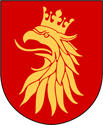


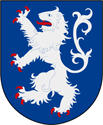







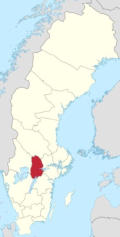



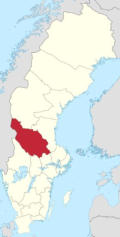
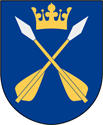





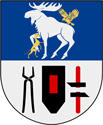

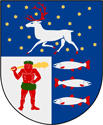
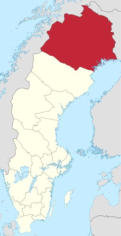

Maps
Map, Swedish Counties
Map, Swedish
Provinces
Map, Swedish
Lands
Map, Swedish County
Codes
Information about the Swedish
Counties
Introduction
The entity for regional administration is called Län in
Swedish. Län is normally translated into county in
English.
The subdivision into counties was introduced in 1634
when Sweden adopted a new constitution. The sole
purpose of the counties is regional administration.
The county lines have changed many times since
1634; the Crown often chose to make slight changes
to suit its purposes. So, counties have been divided
and consolidated over time. In some cases, the
administrative counties correspond almost exactly to
the provinces, in other cases, they do not.
See also The subdivisions of Sweden into Lands,
Provinces and Counties
Counties:



















































































































